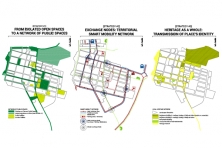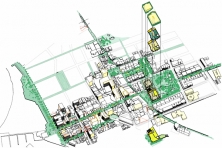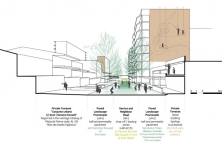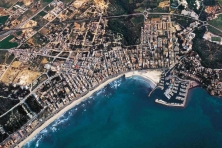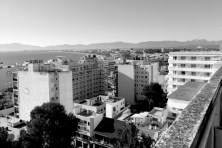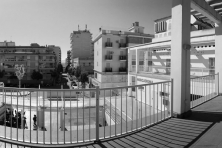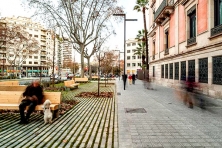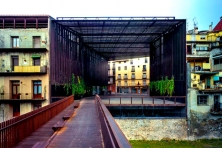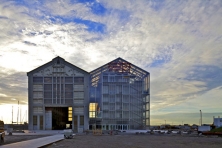AGORA 4.8
Platja de Palma (ES) - Winner
TEAM DATA
Team Representative: Catalina Salvà Matas (ES) – architect urbanist
Associate: Hector Ortín Isern (ES) – architect
Contributor: Pol Sarsanedas Coll (ES) – architect
Salvà Ortín Arquitectes, C/ Provença, 363, 3°2a, 08025 Barcelona (ES)
C/ Grup Escolar, 13, 07620 Llucmajor (Mallorca), Illes Baleares (ES)
+34 935310558 – info@salvaorti.com – salvaortin
See the complete listing of portraits here
See the site page here

P. Sarsanedas Coll, H. Ortin Isern & C. Salva Matas
INTERVIEW
Click on the images to enlarge
1. How did you form the team for the competition?
Catalina Salvà and Hector Ortin formed their own studio six years ago, with sites in Barcelona and Mallorca. Pol Sarsanedas studied architecture with Hector in Barcelona and collaborated previously in a few competitions. We decided to make this competition together to make a deep reflection on a city that was close by some and far away for others, a factor that allowed us to have different looks, and the possibility that the location and the competition offered of perform a very different scales analysis to solve the problems of a site with large urban deficiencies.
2. How do you define the main issue of your project, and how did you answer on this session main topic: the place of productive activities within the city?
The title of the project already tries to be a statement of principles that we intend to achieve: Agora 4.8 means to give s'Arenal a new urban centrality from the implementation of 4 work vectors that work on identity, metabolism, productivity and city urban relations translated into 8 project strategies. The project aims at recovering the identity of the city through spaces that allow citizens to recognize it, redesigning them collaborating with their own metabolism and paying special attention to the management of the water and energy cycle, moving from the consumption to the productive city through the management of natural resources and the incorporation of measures to reduce energy demand and consumption as well as promoting local production, and finally generating a network of public spaces that allow the exchange between the different urban layers.
3. How did this issue and the questions raised by the site mutation meet?
The reflection on the site was born, first of all, by the knowledge of Catalina about the city itself and of its historical becoming, but also implied a recognition of the spaces and problems on the street, with the whole team walking down the city, finding out the problems and shortcomings and discovering new ones, talking with the citizens, doing in situ reflections and, finally, many hours of analysis, proposing, filtering and debugging ideas, which allowed us to define the vectors of action in a very synthetic way but also with the broad and necessary meaning for each project strategy, in order to incise the requirements of the competition and also those the site demanded us.
4. Have you treated this issue previously? What were the reference projects that inspired yours?
We had worked in other competitions trying out strategies to turn urban spaces without activity into new centers by promoting the resources of the site and, above all, proposing new spaces for meeting citizens. In our proposal for Europan 14, however, we wanted to evolve these reflections by incorporating strategies to renaturalize the city and increase the potential of existing buildings through their energy rehabilitation or their understanding as urban centralities inspired by recent projects as the renaturalisation of the Passeig de Sant Joan in Barcelona, the rehabilitation and reconversion of an old industrial warehouse in the new FRAC art center in Dunkerque by Lacaton & Vassal through its energetic rehabilitation or the generation of a new covered place and equipment in the old space of the theater La Lira by RCR.
5. Urban-architectural projects like the ones in Europan can only be implemented together with the actors through a negotiated process and in time. How did you consider this issue in your project?
We think that it is important for S'Arenal that some of the reflections and conclusions that we have reached can be implemented to improve the lives of citizens and visitors. The aim of the project to define the 8 intervention strategies is based on the need to focus on different areas of the city or issues that present deficiencies and deal with them independently but with uniform criteria, and in this sense the 4 vectors of action (which interrelate identity, productivity, metabolism and urban relationships) play a key role, in greater or lesser importance, each according to the necessary strategy.
6. Is it the first time you have been awarded a prize at Europan? How could this help you in your professional career?
Yes, it is the first time we have won and also the first time we participated. At the professional level, we can open a door to the joint reflection with local agents about the urban spaces and the dynamics of this or other cities. It has also provided us with an opportunity to test our reflections on the contemporary city from multiple scales, an exercise that cannot always be done on the professional day-to-day.
